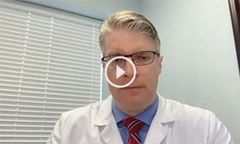
Tepotinib Effective for MET+ NSCLC Found by Tissue or Liquid Biopsy
Giuseppe Giaccone, MD, PhD, discusses the results of the VISION trial of tepotinib in patients with non–small cell lung cancer.
Episodes in this series

Giuseppe Giaccone, MD, PhD, professor of medicine at Weill Cornell Medical College, discusses the results of the VISION (NCT02864992) trial of tepotinib (Tepmetko) in patients with non–small cell lung cancer (NSCLC).
The investigators of the open-label phase 2 VISION trial administered tepotinib to 152 patients with stage IIIb/IV NSCLC who had the MET exon 14 skipping mutation. The MET gene is an oncogenic driver, and the MET exon 14 skipping mutation is found in 3% to 4% of patients with NSCLC. The patients were divided into 2 groups based on whether the mutation was detected by a tissue biopsy or liquid biopsy. Patients received 500 mg of tepotinib daily.
The primary end point was objective response rate (ORR) by an independent review committee. The independent review found a ORR of 46% and a median duration of response of 11.1 months. The ORR was 48% (95% CI, 36%-61%) among the 66 patients in the liquid-biopsy group and 50% (95% CI, 37%-63%) among 60 patients in the tissue-biopsy group. The response rate was similar in patients regardless of previous therapy they had received for advanced or metastatic disease, including platinum-based chemotherapy and immune-oncology.
Grade 3 adverse events related to tepotinib were observed in 28% of patients, including peripheral edema in 7%, and adverse events led to permanent discontinuation of tepotinib in 11% of the patients.
Following the results of the VISION trial, the FDA approved tepotinib for treatment of metastatic NSCLC in patients with the MET exon 14 skipping mutation.
TRANSCRIPTION:
0:08 | What is interesting is that the response rate was similar in patients that had a [tissue] biopsy-proven MET skipping mutation as well as liquid biopsy. So, again, many of these patients with lung cancer don't have enough tissue, especially after the first-line treatment. The tissue may be exhausted or may not be sufficient for next-generation sequencing. So, liquid biopsy is clearly a good way of addressing the lack of tissue.
What is interesting is that there was activity both in patients who were not previously treated with any treatment—chemotherapy, in most of the cases—and in patients who had never been treated before and patients that were treated before. So there was significant activity in both groups of patients. In fact, the drug is approved for both first-line and second-line all further lines of treatment.















































